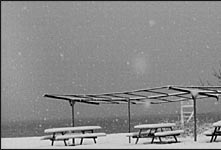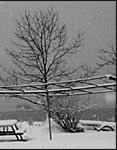



| Below are entries from Village Creek's 50th Anniversary booklet that were compiled from various publications over the years. Together they provide a glimpse into the unique and special character of the community. |
We Built a Community for Our Children from an article by Betty Friedan in Redbook, March 1955 In South Norwalk, Connecticut, 40 young families have transformed a swampy wasteland into a beautiful community of modern homes that look out on sunny woods, island-dotted inlets and open sea... It started one night almost seven years ago in the crowded New York City apartment of Ann and Bob Seidman. Five couples sat around gloomily and agreed that it just wasn't possible to buy or build a modern dream house, with adequate land and trees, for $10,000.... "Let's face it," Bob said to his friends. "None of us can afford to build alone. Maybe there's some way we could do it together." Suddenly his brother-in-law, Roger Willcox, got up and said, "Let's build our own community - the way we want it." The others agreed. It took almost a year of weekend searching to find the place. When they were tired, they sometimes retreated to eat sandwiches in the wild waterfront woods behind the swampy factory wasteland of Norwalk, Connecticut - a deserted area where only hunters and fishermen ever came. One day, watching a bufflehead duck dive into the creek, Ann sighed, "Wouldn't it be nice to live in these woods...." top of page |
How Integration Works in the Suburbs from an article by Irene Backalenick in Sepia, December 1974 Village Creek, a small waterfront community that is part of the city of Norwalk, Connecticut, is in many ways suburbia at its best. A planned, interracial community for 65 families, it is both an oasis from the outside world and a working model of what that world might be... Village Creek families from all indications are living out the American dream, and one of those families is the Brodnaxes, affluent, busy, typically suburban, and black. Both Clarence and Rhenda Brodnax are professionals who work full time, he as a social worker in the Norwalk schools and she as a first-grade teacher in Stamford, Conn. Weekends are given over to activities with their son Carl, 13, and 10-year-old twin daughters, Cheryl and Chanda... The Brodnaxes are among an increasing number of black middle-class families who are breaking out of what the U.S. Commission on Civil Rights has described as "a white noose," the belt of fancy suburbs surrounding and stifling black inner cities... Victor and Carroll Lewis moved to Village Creek 15 years ago, leaving a walk-up flat in New York City for the community's "almost perfect facilities," a place "where your children could play outdoors safely." They wanted the best for their children, educationally as well as environmentally. Victor Lewis is one of the six black architects in Connecticut, and Carol Lewis, newly-appointed coordinator of a pilot project under the Norwalk Headstart program, has been involved in early childhood education since her graduation from Sarah Lawrence College. She was director of the Community Cooperative Nursery School in Rowayton, Conn., for eight years. "Our goal was to give our children an experience where they could know all kinds of people while growing up... " says Mrs. Lewis... Village Creek, as the adult generation sees it, has largely fulfilled the early hopes of its (founders) ... The community, over the years, has kept a balance of roughly 40 percent non-white residents, including blacks, Indian, Japanese, Chinese and interracial families, with a mixture of religious persuasions. top of page |
Village Creek: a Friendly Melting Pot from an article by Jerry Schmetterer in the (N.Y.) Sunday News, September 25, 1975 ... The typical home was left up to the individual family, subject to approval by the still very active Architectural Committee, and a number of styles emerged, ranging from small summer residences to lavish contemporary buildings, some of which are worth almost $100,000 today. What emerged as the lots were bought up and the homes built was a mini-city which included tradesmen, artists, doctors and teachers. While most were young struggling families in 1949, they have done well over the years and today the community has taken on a prosperous identity. Mildred Morganstern.... operates a successful boutique, The Mexican Room in Darien. Joseph Lasker, vice president of VCHOA, was a struggling artist and writer in 1949. Today he is a successful author and illustrator of children's books.... and uses Village Creek for inspiration. top of page |
Village Creek: A Sense of Community from an article by Bruce Shapiro in Fairfield County Advocate, November 25, 1981 ...From the outset, Village Creek attracted people who shared (the founder's) notion of community, including many artists and professionals, some of them well-known leaders in their field. Antonio Frasconi, an internationally-known woodcut artist, lives in Village Creek; much of his work is inspired by the birds and marshes visible from his studio. Frank Donner also lives there; he is a constitutional lawyer known for battling the House Un-American Activities Committee and for his recent book on Government domestic spying, The Age of Surveillance. Dr. Les Allen, who ran a pioneering clinic in Harlem, was one, of Village Creek's founders... Anita (Willcox), who at 89 still lives in her own Village Creek house, won a landmark lawsuit against the State Department in the early '50s over the right to travel to China. (Roger) Willcox himself, after his experience in starting Village Creek, took up community planning as a profession, and is on the board of directors of the National Association of Housing Cooperatives. Judge Jane Bollen, Connecticut's first black Superior Court judge, was also a Village Creek resident... Roger Willcox's son Peter was captain of the environmental-action sloop Clearwater for five years.... Today, Peter Willcox is captain of another environmental-action boat, Greenpeace's Rainbow Warrior... ln the '50s Village Creek led a six-year fight to block Connecticut Light and Power from building a power plant on nearby Manresa Island. The power plant was eventually built, but with environmental restrictions almost unheard of in the early '60s.... Then there is Alan Dikeman. Dikeman is a Democratic ward committeeman in Norwalk and a fanatical anti-Communist. For the past six years, shortly before Election Day, he has issued broadsides and taken out advertisements in the Norwalk Hour, accusing Village Creek and various residents of Communist subversion. "The first time it happened," Barbara Kerschner remembered, "we were horrified. It was so vicious." At one point legal action was contemplated, but now residents just live with it. According to Willcox, "Village Creek as a whole has never taken positions on political issues. The community has fought to protect that position...." Over the years, Village Creek has proved to be a remarkably stable community. Fifty percent of the families who originally built houses still live there, and several have been passed on to children. It is still largely a professional community, populated mostly by artists, architects, teachers, psychiatrists and lawyers. Through most of the '70s, the number of school-age children steadily declined, but now there are four expecting mothers. Some things, however, are changing, more a result of outside influences than Village Creek policy. "The idea of an integrated community isn't new or unique any more," said Barbara Kerschner. "People come here now more for the physical qualities." And there has been gentrification, as development made the land more valuable and area real estate boomed. The original Village Creek lots ranged in price from $500 to $3500; now, (Roger) Willcox estimates, they are worth 10 to 20 times those figures without a house. top of page |
Neighborhoods - The Ebb and Flow of Village Creek from an article in the Norwalk News, August 15, 1985 ...the Manresa Island landscape offers some of the most beautiful shoreline Norwalk can claim. Salt marshes and wildlife abound, and the changing tides cause startling alterations to the environment's design. Yet, those changes are part of an age-old pattern of ebb and flow, accomplished with the silence of the passage of time. The island has had several ownerships over the years and once included a one-half mile racecourse built by a former owner, John H. Keyser, for whom the island was once also named. Later, in 1987, the area served as a retreat for Catholic clergy and was called Manresa Institute. Today, after some reconstruction by Connecticut Light and Power that involved the adjacent shoreline neighborhoods of Harbor View and Village Creek in lengthy court battles, the island's horizon is now divided by the massive power station built there in the early '60s... (In 1949) Village Creek was a neck of uninhabbited woods crisscrossed by old fishing trails, and more recently, it was a former Girl Scout campground. In 1949, it was owned by Nash Engineering, which wanted to sell the property... With $75,000, invested in part by artist and peace advocate Anita Willcox,...Village Creek was purchased and the planning began to take shape... "We wanted our kids to learn how to live with people of all kinds, all incomes, all races and religions. We weren't making a conscious effort to integrate: we just did not discriminate about which of our friends we would invite to buy and build down here," said (Roger) Willcox... While the type of home to be built on the 74 sylvan building lots was left up to the individual homeowners, the fledgling Village Creek Homeowners Association drew up a series of covenants ensuring that future use of parcels would continue in the spirit intended... Of the five original families that formed Village Creek, all are still residents or represented by descendants there; 50 percent of the original houses are still owned by the same family. The racial balance has also remained virtually the same. It also has continued to offer its new residents the sense of neighborhood that marked its inception. John Phillips, creator of Aristotle Inc. in Norwalk and a relatively new resident of only five years, observed, "When I first came to be involved in politics, a group of residents there were very generous with their time and resources to support my candidacy. They are genuinely involved in their town and have a strong sense of community, all the way up to the national and international levels." Doxey Wilkerson remarked, "I can still enjoy the daily experience of tranquillity here; there's no pollution, no over intimacy. It's a friendship by choice." Barbara Kerschner added, "We don't pop in, we don't have bingo games; we lead separate lives. Those who came respected the individuality here; that respect remains. We take care of our need for solitude. It's kind of an unspoken thing." "We are just a neighborhood," concluded Emily Oppenheimer, "I don't know how many people are black or whatever; I guess we could look at a map and count...but it just doesn't matter. I know them as people, neighbors, friends." top of page |
Keeping a Postwar Dream Alive from an article by Alberta Eiseman in the Connecticut section of The New York Times, August 4, 1996 No gatehouse or stone pillars mark the entrance, just a plain wooden sign announcing Village Creek. Three roads wind through the residential community in South Norwalk, shady streets with views of salt marshes and Long Island Sound, leading to houses all but hidden by ancient trees. A visitor notes the way the homes nestIe into the land, the spare but elegant architecture recalling the 1950s, the added wings and porches that speak of growing families and changing needs... "Those of us who started Village Creek had a special kind of a community in mind," read the prospectus published in 1951. "We were looking for a good place in which to live and bring up our children, a community which would be in itself a model of democracy. We wanted a healthful place to live, waterfront, view....but above all else we wanted a community with a completely democratic character - no discrimination because of race, color, creed or politics." What they developed, explained Roger Willcox, one of the community's principal organizers, was a cooperative, integrated community that offended many at that time. For 10 years, no real estate broker would show a Village Creek house to a white family, but the residents organized a committee that saw to it that homes were sold by word of mouth. "Now, the integration factor is no longer unusual," said Mr. Willcox on a recent day, as he sat on his porch overlooking boats at their moorings and the Norwalk islands in the distance, "it's the harbor that is unusual. Now we are attracting families with boats and most of them are white. We make a constant effort to maintain the racial integrity of the community." Such efforts sometimes lead to unusual situations, like the time during the 1960s when the Village Creek Homeowners Association tried to dissuade a prominent black couple from buying a house in a corner of the community where numerous black families already lived.... "The prospective buyers were offered several other properties that were available, but they insisted on that very one and brought charges against the association," (Roger Willcox related.) The ensuing legal maneuvers - with the local N.A.A.C.P. weighing in on the side of Village Creek - made the headlines as a rare case of reverse discrimination and consumed more than a year. During that time several other homes changed hands, making the racial balance more equitable in the disputed area. The homeowners association eased its stance, the family bought the home they loved and they are still there... Other controversies, unrelated to race, have dogged Village Creek over the years.... In recent months, the combat has concerned a rock-crushing operation that a contractor wanted to install on Wilson Avenue, within sight and hearing of Village Creek homes.... Opponents feared that dust, loud noise and additional truck traffic would degrade the The fight was joined by neighbors from an extended area... Both sides had employed lawyers as well as experts in acoustics, traffic, pollution control and environmental matters and dozens of residents had spoken out at meetings of the Norwalk Planning and Zoning Commission.... Last week, the Planning and Zoning Commission voted 4 to 2 to deny the application for the crushing machine and the community was able to return to its routine. For all the controversies, present and past, Village Creek has remained a remarkably peaceful, stable community. The covenants that were established at the start are still in force. The three- person Architectural Control Committee remains the arbiter of all exterior changes, and any tree that stands four feet above ground cannot be cut down without permission. Residents volunteer to do common chores like painting the lifeguard stand and picnic tables every spring, and parties at Christmastime and the Fourth of July bring forth the best talents of neighborhood cooks. top of page |